
This lab video demonstrates how to perform a PCR (Polymerase Chain Reaction) in the laboratory setting.
- Subject:
- Biology
- Science
- Material Type:
- Lecture
- Provider:
- LabXchange
- Provider Set:
- LabXchange Videos
- Date Added:
- 10/25/2023

This lab video demonstrates how to perform a PCR (Polymerase Chain Reaction) in the laboratory setting.
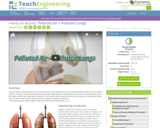
To gain a better understanding of the roles and functions of components of the human respiratory system and our need for clean air, students construct model lungs that include a diaphragm and chest cavity. They see how air moving in and out of the lungs coincides with diaphragm movement. Then student teams design and build a prototype face mask pollution filter. They use their model lungs to evaluate their prototypes to design requirements.

In this video segment adapted from A Science Odyssey, follow two scientists and their Nobel Prize-winning efforts to cure bacterial infections using penicillin.
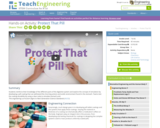
Students reinforce their knowledge of the different parts of the digestive system and explore the concept of simulation by developing a pill coating that can withstand the churning actions and acidic environment found in the stomach. Teams test the coating durability by using a clear soda to simulate stomach acid.
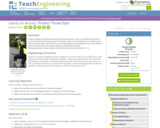
Students design and build prototypes for protective eyewear. They choose different activities or sports that require protective eyewear and design a device for that particular use. Students learn about the many ways in which the eyes can be damaged and how engineers incorporate different features and materials into eyewear designs to best protect the eyes.

This interactive introduces how mistakes in the genome can cause disease. The gene editing tool CRISPR-Cas9 can correct these mistakes and potentially cure disease.
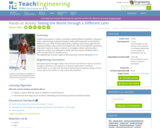
Students participate in a variety of activities modeling different disabilities. They gain a better understanding of physical limitations while performing tasks at workstations without the use of their thumbs (taped down), impaired vision (various glasses) and impaired mobility (using crutches and wheelchairs). After discussing their experiences, they work in teams to create or improve on an adaptive device. Like biomedical engineers, students are challenged to design with the purpose of helping make a particular task easier for another person.
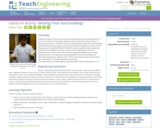
Students consider human senses and the many everyday human-made sensors so common in their lives. They learn about the three components of biosensorsâa special type of sensorâand their functions and importance. With this understanding, students identify various organs in the human body that behave as sensors, such as the pancreas. Using LEGO® MINDSTORMS® NXT robots, provided rbt robot programs and LEGO sensors (light, ultrasonic, sound, touch), students gain first-hand experience with sensors and come to see how engineer-designed sensors play important roles in our daily lives, informing people of their surroundings and ultimately improving our quality of life.

All the cells in all animals have a complete set of genes with the instructions for building an organism. Working with mutations in fruit flies, scientists have found a group of regulatory genes called Hox genes that signal other genes in sequence to build the body of an animal. All animals except sponges have Hox genes. [6:04]
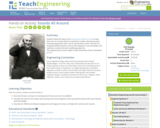
Students follow the steps of the engineering design process to create their own ear trumpet devices (used before modern-day hearing aids), including testing them with a set of reproducible sounds. They learn to recognize different pitches, and see how engineers must test designs and materials to achieve the best amplifying properties.

Students learn about stem cells, and how these cells are used in medical research and treatments. Find out scientific facts, read several case studies, and participate in a group debate activity to explore the ethics of this topic. A self-check quiz follows the learning activity.

This pathway introduces you to the virtual lab simulations available on LabXchange, and how these simulations can be used to teach lab skills like gel electrophoresis.

This pathway outlines how genetic information is added to cells in the technique called transformation. This pathway also supports ABE Lab 5.

This pathway introduces the micropipette, an instrument used to measure small volumes of liquid, and provides an opportunity to practice using this tool. This pathway also supports ABE Lab 1.1: How to Use a Micropipette.
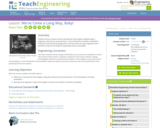
Students discuss several human reproductive technologies available today pregnancy ultrasound, amniocentesis, in-vitro fertilization and labor anesthetics. They learn how each technology works, and that these are ways engineers have worked to improve the health of expecting mothers and babies.

In this teaching video, high school teachers Anu Deshpande and Aaron Matthieu explain what a plasmid is and why it is a useful tool in biotechnology.
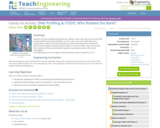
Students use DNA profiling to determine who robbed a bank. After they learn how the FBI's Combined DNA Index System (CODIS) is used to match crime scene DNA with tissue sample DNA, students use CODIS principles and sample DNA fragments to determine which of three suspects matches evidence obtain at a crime location. They communicate their results as if they were biomedical engineers reporting to a police crime scene investigation.

A new virtual interview series from LabXchange at Harvard University, the Xchange showcases the diverse roles, projects, and initiatives that make up the intersecting fields of science, education, and health. Hosted by LabXchange Faculty Director Robert Lue, the first season features a range of perspectives on the impact of COVID-19.
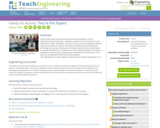
Student teams learn about and devise technical presentations on four reproductive technology topics pregnancy ultrasound, amniocentesis, in-vitro fertilization or labor anesthetics. Each team acts as a panel of engineers asked to make a presentation to a group of students unfamiliar with the reproductive technology. Each group incorporates non-lecture elements into its presentation for greater effectiveness. As students learn about the technologies, by creating a presentation and listening to other groups' presentations, they also learn more about the valuable skill of technical communications.

Explains basic genetics concepts, including genes, DNA, chromosomes, sex chromosomes, how traits are inherited, genetic variation, cloning, and stem cells.